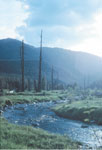What's at StakeThe Clark Fork of the Columbia, Blackfoot, Bitterroot (named Clark's River by Captain Lewis) and the Big Hole Rivers are filled with cold, clear water - snow melt from high mountain peaks. Large herds of elk and deer roam meadows and lowlands, moose and beaver thrive in the lush, willowed wetlands. In some places in the Bitterroots, wolves are beginning to return, but the grizzly bears, lynx and fishers that once wandered these mountains are seldom, if ever, seen. The Bitterroot Crest threads through unprotected wildlands which are critical to connecting the wild country of western Montana to central Idaho. The Great Burn - an important 200,000-acre roadless area cherished for its abundant wildlife, is key to maintaining this corridor and has been recommended by the Forest Service for permanent wilderness protection. The land is unquestionably wild. Wolves have found enough solitude to raise their young in the Great Burn and the elusive wolverine has been sighted there. Moose and black bear are often seen among the spectacular wildflowers and ghostly snags that remain after the great burn that swept through the area in 1910. The ThreatsThe tranquil Great Burn area has been under assault, having caught the attention of the snowmobile industry. Recently promoted as "the triple-black diamond of world class snowmobiling areas," the Great Burn has seen a ten-fold increase in snowmobile use between 1991 and 1996. Increasingly, the area is being invaded by other motorized recreation users, threatening water quality, disrupting wildlife habitat and destroying the wild character of these lands which have been nominated several times for wilderness designation and protection. In addition, the pressure to log in unprotected roadless areas continues to mount as other areas are logged-out. The SolutionsThe Sierra Club, along with other conservation groups, is working to keep motorized vehicles out of wild places like the Great Burn. Intense public pressure recently forced the Forest Service to close the area and some adjacent roadless areas to snowmobiles. However it is not time to declare victory. More than 70 percent of the Lolo National Forest remains open to snowmobiles, including 300,000 acres of wildlands that were not protected by the Forest Service decision. In addition, the Montana Snowmobile Association filed a lawsuit to fight the interim decision. The only way to provide permanent protection for the wildlands and wildlife seen by Lewis and Clark in the Bitterroot Mountains is to secure wilderness status. Restoration is also crucial to protecting the Bitterroots. The Lolo Pass area has been laced with roads and damaged by logging. This area is a vital connection between the Selway-Bitterroot Wilderness to the south and the proposed wilderness and roadless areas to the north. A natural wildlife corridor, the Lolo Pass area needs a restoration program of road obliteration, reforestation and stream channel restoration so that it can again function as a corridor for elk, wolves, bears and deer, and as vital fish habitat for native bull and cutthroat trout. Photo by George Wuerthner
| |||||||


